The threads of the story are starting to tie together. The handout from Fear and Loathing is an article written by Tallie Perrault of the Opticon Foundation about how the tsunami that hit New Angeles was caused by drilling at an offshore platform and could have been prevented had upper management chosen to listen to seismologists at the facility. In addition, we learn that the platform, GRNDL, was owned by Strata Corp., the Weyland subsidiary where the bioroid intrusion took place. So we have the why now, and it remains to be seen how the story will conclude. For now, let us look at the cards from this pack.
Quest Completed
There are times when you just might not be able to get into a remote server, especially when the corporation is using it to score out their agendas. Well, with this card, you can access a card the corporation has installed. The catch is that you need to have made a successful run on R&D, HQ, and Archives in the same turn. So instead of breaking into one server, you have to break into 3. Granted, there might be fewer defenses on the central servers than on the scoring server, but it can still be difficult to pull off. As such, you will want to invest your resources into making those runs successful, and possibly into getting some extra time in your turn to do so.
Pair cards: Inside Job, Sneakdoor Beta, Doppelgänger, All-nighter, Alias, Breach, Passport
Hemorrhage
For a while, this was a fairly popular card. Every time you make a successful run while this is installed, it gets a counter. By spending 2 counters and a click, you can force the corporation to trash one of the cards in their hand. So you could build up a bunch of counters on this and force the corporation to decide which of the cards they are holding onto are the least beneficial. Or you could drop them to the point where you could access all the cards in their hand at once. The 4 influence makes this somewhat difficult to play outside of Anarch, but if you need to control the corporation a bit more, this could be helpful.
Pair cards: Déjà Vu, Cyberfeeder, Grimoire, Djinn, Desperado, Surge, Incubator, Hivemind, MemStrips
Tallie Perrault
Well, this is somewhat interesting. As we have seen, operations have subtypes. For the most part, these subtypes have not had much impact on the game (except for transaction with Weyland Consortium: Building a Better World,) but now it is possible to punish the corporation for playing specific operations. If the corporation plays a gray ops or black ops operation, then when it goes to the Archives after being resolved, you may give the corporation 1 bad publicity and take a tag. So if they do something morally questionable, such as Closed Accounts, or outright illegal, such as Scorched Earth, you could give them bad publicity as a result. That combines with her other effect, which allows you to trash her in order to draw 1 card for each bad publicity the corporation has. So if the corporation has built up some bad publicity and tries to murder you, you might be able to soak up the damage with her ability. Plus, it works in the space between actions, so it is possible to utilize her effect after the corporation tags you, but before they play their kill cards. Granted, to get a surefire effect out of her, you have to be giving the corporation bad publicity. Otherwise, you are dependent on what the corporation is doing, which may make this a useless card.
Trivia: Tallie Perrault is the protagonist of the Android novel Strange Flesh, by Matthew Farrer. In that one, she is interrogated by Caprice Nisei of the NAPD, who reads her memories as she gives her account of her investigation into Jinteki corporation. She is also a minor character in the novella Monster Slayer, by Daniel Lovat Clark. In that one, she gives Reina Roja some information on GRNDL.
Pair cards: Frame Job, Raymond Flint, Valencia Estevez: The Angel of Cayambe, Itinerant Protesters, Investigative Journalism, Corporate Scandal, The Archivist
Executive Wiretaps
I have not really seen this card get much use, which is odd, considering how powerful its effect is. For 4 credits and 2 clicks, you force the corporation to show you all the cards they are holding in HQ. If you see multiple agendas, you can run there to try and score them. Or if there are no agendas, you can run on R&D instead. Or you can just know what the corporation can do on their upcoming turns. The big downside is spending 4 credits can be quite a setback, but Criminal can make large piles of cash, so they can pull this off.
Trivia: The Netrunner CCG does have a card named Executive Wiretaps, but instead of revealing all the cards in the corporation's hand, you make a run on HQ, and if successful, you access 2 additional cards.
Pair cards: Sneakdoor Beta, HQ Interface, Prepaid VoicePAD, Legwork
Blackguard
A very expensive console with a very powerful ability. You gain 2 memory on installing this, which is not quite enough to justify the cost, but whenever you expose a card, the corporation must rez it by paying its rez cost, if they have enough money to do so. With this, you can force the corporation to rez expensive ice, draining them of credits. You can force them to rez assets and upgrades, making them less surprising later on. And if you can force them to derez these cards, you can force them to pay for them again, draining them further. However, if there is an additional cost to rez the card, you can not force them to pay that cost, so you are unable to force them to forfeit agendas. The big problem is getting the money to install it. While Criminal is capable of making that much money, spending it is quite a setback. Still, if you can keep the corporation down, then you may be able to run rampant on them.
Trivia: This is the console of Silhouette: Stealth Operative. It pairs expertly with her ability, and you can tell that this is the helmet she is holding in her hands on her card art.
Pair cards: Forged Activation Orders, Lemuria Codecracker, Modded, Infiltration, Satellite Uplink, Emergency Shutdown, Snitch, Raymond Flint, Drive By, GPI Net Tap, Deuces Wild, Spot the Prey
CyberSolutions Mem Chip
Sometimes, you need more memory. And sometimes, you need a lot more memory. This card give you 2 points of memory for 4 credits, giving you an exchange of 2 credits per memory unit. That is slightly more expensive than Akamatsu Mem Chip, but cheaper than Dyson Mem Chip. Perhaps the main benefit of this is deck compression, as running these means you have to run fewer copies of the other memory chips. Also, while it has a memory value comparable to some consoles, you can only have one console installed, while you can have multiple copies of this chip installed. So if you need lots of memory but need to keep your deck lean, this could be a decent solution (pun not intended.)
Trivia: Another reprint here. In the Netrunner CCG, the card is called Zetatech Mem Chip, although it only costs 3 to install.
Pair cards: Kate "Mac" McCaffrey: Digital Tinker, Modded, Inside Man, Replicator
Alpha
Not really seen that often. The high install cost is one problem. The other problem is that while this is an AI icebreaker, and can break any type of ice, this card can only be used to break the outermost piece of ice protecting a server. Still, you can use this to get into any server that only has one piece of ice on it. Also, you could use this to make running into servers a bit safer, as with this, you can always break the outermost piece of ice, making face checking a bit safer. Just watch out if there are multiple pieces of ice on a server, and the corporation just lets you through the outermost one.
Pair cards: Cyberfeeder, Modded, Test Run, Multithreader
Omega
And now we have the flip side of Alpha. Omega is also an expensive AI breaker, which can only be used to break the innermost piece of ice protecting a server. Once again, every server with ice will have a piece at the innermost position, so you could get use out of this, but only if you can reach that piece of ice in the first place. It also costs as much to use Omega as it does Alpha, so with either icebreaker, you will likely need to build up your credit pool to utilize them.
Pair cards: Cyberfeeder, Modded, Test Run, Multithreader
Blackmail
A very powerful card indeed. With this, you can run on a server and the corporation is unable to rez any ice on that server. So you could easily get into the scoring server, or breach any of the central servers. The catch is the corporation has to have a bad publicity in order for you to play this card, so to get use out of this card, you have to give the corporation at least one point of bad publicity. So unless the corporation can rez their ice on their turn, you can sit back and wait for the opportune moment to use this.
Trivia: I think I have stated before that there is a card in the Proteus expansion to the Netrunner CCG called Blackmail, which is vastly different. It costs 12 to play, and forces you to make a run on HQ, but if that run is successful, instead of accessing cards, you gain an agenda point.
Pair cards: Frame Job, Raymond Flint, Valencia Estevez: The Angel of Cayambe, Investigative Journalism, Corporate Scandal
Blue Level Clearance
An advanced version of Green Level Clearance, this card compresses clicks further. By spending 2 clicks, you gain 3 credits and draw 2 cards. Of course, this typically means you will only have 1 click left for your turn, so it is better to use this once you have your defenses in place and need to draw back up. It is still very advantageous, and can be used quite effectively.
Pair cards: Weyland Consortium: Building a Better World, Cerebral Imaging: Infinite Frontiers
Strongbox
Sort of the HB equivalent of Red Herrings, in that this card adds an extra cost to stealing agendas. But instead of having to pay 5 credits, the runner must spend a click to steal an agenda. If they have not budgeted their time well, they may be unable or unwilling to spend that click, which gives you an extra turn to score out your agenda. The drawback is that this card has a low trash cost, so the runner will likely destroy this card and then can make another run to try and steal your agendas. So to get the most use out of this card, you will have to tax the runner's clicks.
Pair cards: bioroid ice, Hourglass, False Lead, Enhanced Login Protocol, Heinlein Grid, Prisec
Toshiyuki Sakai
This is interesting. Toshiyuki is an asset that can be advanced, which means that he can look like an agenda to the runner. But, when the runner accesses him while installed, you are allowed to swap him with an asset or an agenda in your hand, and gets all the advancement counters that were on Toshiyuki. Of course, if you do that, the runner is free to choose not to access, so if you put out an agenda and they think it is a trap, then you can score an agenda. Of course, the runner may just think he is a trap to begin with, or might expose him, so you may need some extra cards to take advantage of the tokens piled up on him.
Trivia: Toshiyuki Sakai is the Senior Director overseeing the Nisei project, and as such, Caprice Nisei reports to him. He is a minor character in the novel Strange Flesh, and in the novella Exodus, by Lisa Farrel.
Pair cards: Project Junebug, Fetal AI, Trick of Light, Plan B, Back Channels
Yagura
A very cheap code gate with an interesting ability. This card does not stop the runner, but instead allows you to look at the top card of your deck. You can then decide whether to leave it on top of the deck or move it to the bottom of your deck. So if you see an agenda, you could move it away so the runner will not access it. Or if it is a trap, you can leave it in place. Or you could try bluffing, leaving an agenda on top, or moving an irrelevant card to the bottom, to trick the runner into aborting their run. Also, this card can potentially do a point of net damage to the runner, so if you need something to round out your ice suite, this is not a bad card to include.
Trivia: Yagura is the Japanese word for "tower," "turret," "keep," or "scaffold." It can serve as a watchtower or guard outpost, or possibly just storage. Yagura is also a piece in the Japanese game of Shoji, which can be used to maintain a strong defensive position.
Pair cards: Encrypted Portals
Restoring Face
Sometimes, bad publicity just piles up, and you have to make a sacrifice. This card allows you to remove up to 2 bad publicity at no cost, but you have to trash an installed sysop, executive, or clone. That can be beneficial if it is a card you are no longer using or need, but this is only really beneficial if you have been gaining bad publicity to begin with. As such, it is better to use this card to clear away the bad publicity you have been giving yourself, instead of trying to remove bad publicity the runner may have been giving you.
Pair cards: executives, sysops, and clones, Profiteering
Market Research
At first, this appears to be just a 4 advancement requirement agenda worth 2 points. However, if the runner is tagged when you score this, then you can place an agenda counter on it. While it has an agenda counter on it, it is worth an extra point. So this could be worth 3 agenda point to you, which means you might need only 3 agendas instead of 4. Of course, to take advantage of this effect, you have to be able to land at least one tag on the runner, which is not always possible.
Pair cards: Psychographics, SEA Source, Data Raven, Midseason Replacements, Hard-Hitting News
Wraparound
A really good early game ice, especially if your opponent is relying on AI icebreakers. While there is no installed fracters, this card gains 7 strength, which can make it quite expensive for an AI to break. Of course, once the runner has installed a fracter, it drops back down to 0 strength, becoming trivial to break. Still, this card could let you score out 1 or 2 agendas in the early game, and you could leave it in place so they have to spend an extra credit or two getting in.
Pair cards: Superior Cyberwalls, Sub Boost
GRNDL: Power Unleashed
At long last, we come to the only corporation identity in the cycle. And it is quite an effective one. When you play as GRNDL, you start the game with 10 credits and 1 bad publicity. In a way, it is like you had a free turn and scored out a Hostile Takeover, but without the agenda point. As such, the extra money means you can use more expensive ice earlier on, and can use Restructure on your first turn for even more money. The main drawback, aside from the bad publicity, is that your influence is lowered to 10, so you will have to cut back on what you pull in from other factions. But if you need to jump start your early game, this is not a bad identity to run. You'll just have to decide whether you want to get rid of your bad publicity or double down on it.
Trivia: As the insert has stated, some people have taken to calling GRNDL as "Grendel," which is a reference to the epic poem Beowulf. Grendel was a monster who attacked the mead hall of Hrothgar of the Danes every night until Beowulf arrived. Beowulf spent the night in the mead hall, ambushing Grendel and slaying him.
Pair cards: Elizabeth Mills, Restructure, Profiteering
Vulcan Coverup
An interesting agenda that has not seen much play. When you score this card, you do 2 meat damage to the runner, which could help set up for a kill. The catch is that if the runner manages to steal one of these, then you have to take 1 bad publicity. As such, this could be used to augment a tag and bag deck, but you may have to leave it lying around in order to properly utilize it.
Trivia: Project Vulcan was the code name for the drilling operation at the GRNDL site. The coverup was a result of Reina Roja stealing the memos from a secured server and releasing them to various organizations such as the Opticon Foundation, the NAPD and Consejo por un Ecuador Libre, or CEL. The events of the coverup are part of the novella Monster Slayer.
Pair cards: Scorched Earth, The Cleaners
GRNDL Refinery
A card that can potentially make you a lot of money. Each advancement token you place on this card can be worth 4 credits back. Of course, you have to rez it and then spend a click and trash it. As such, this could play out several ways. If the runner thinks this is a trap, you might be able to advance this for a few turns and get a huge payout. But if they think it is an agenda, they might spend a lot of resources getting to this and trashing it, denying you that massive boost to your economy. If that happens, you might be in a worse position, if it did not cost them a lot to get to this. But if you think you can make this work, then it could set up your finances for a while.
Trivia: This card is a reprint. From the Netrunner CCG, we have Information Laundering, which has the same effect, but only costs 1 to trash.
Pair cards: Mushin No Shin, Dedication Ceremony
Subliminal Messaging
This card is interesting. It gives you a credit, which does not seem like much, but then it gives you a click if you have not played another copy of this card. So essentially, this gives you 1 credits without spending a click. But, if the runner does not make a run on their turn, you can add this card to your hand from your discard pile when your turn begins. So by playing this card, you can force the runner to spend a click on each of their turns to make a run, or they let you take this card over and over, which helps build your economy. As such, this card can make a huge difference in the early and mid game, but you will likely get less use out of it in the late game, when the runner can attack your servers much more effectively.
Pair cards: anything
And that does it for Fear and Loathing. Next time, we finish the Spin Cycle with Double Time.

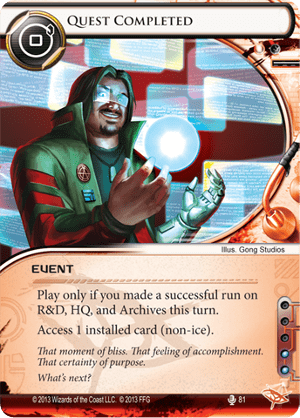
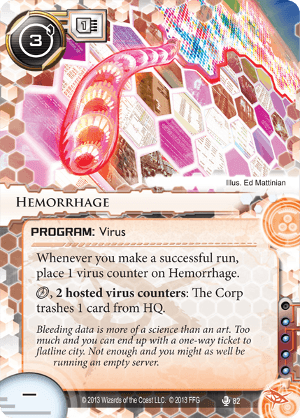
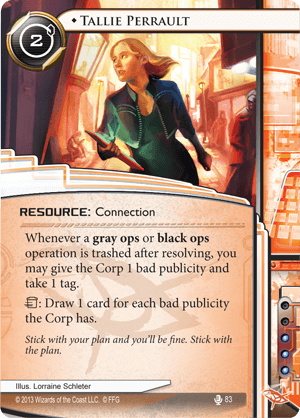
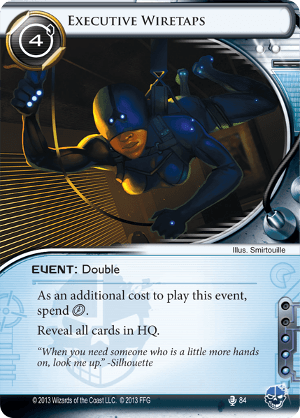
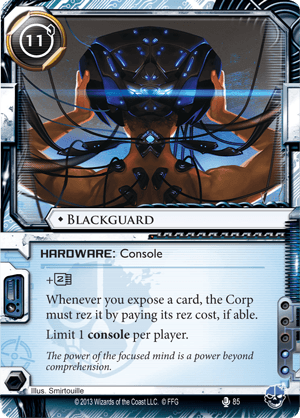
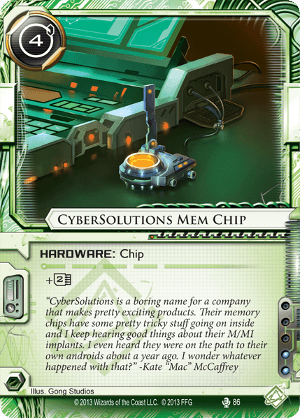
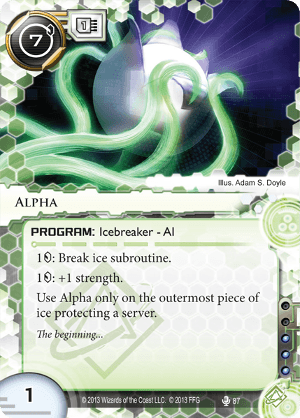
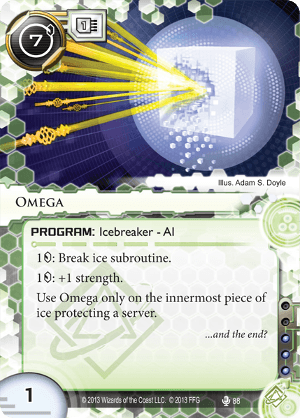
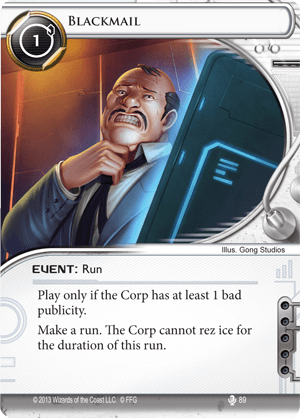
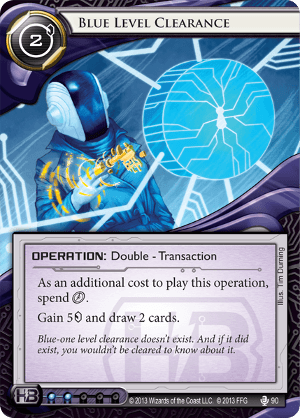
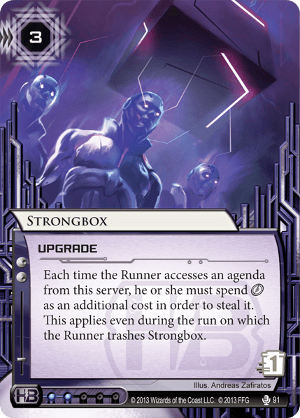
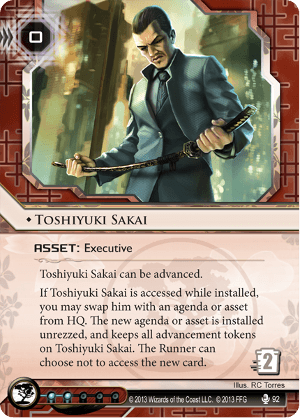
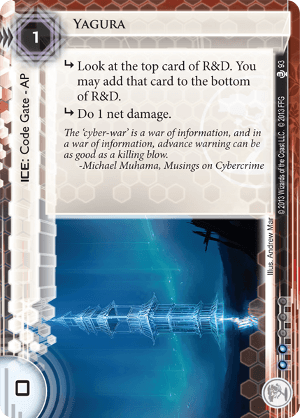
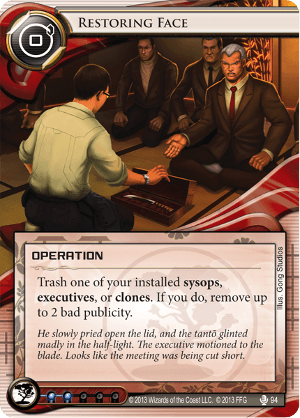
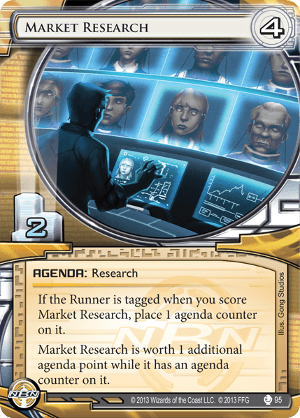
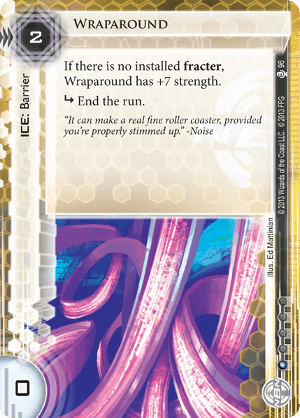
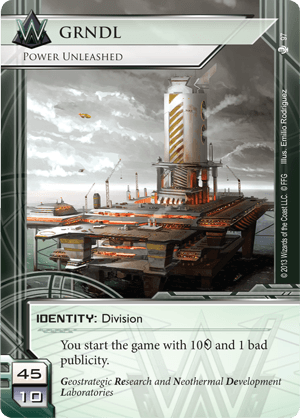
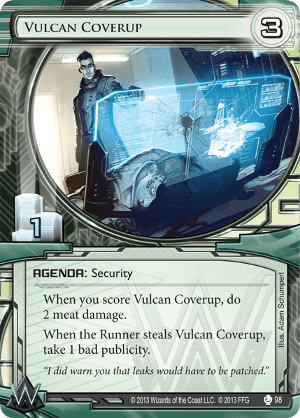
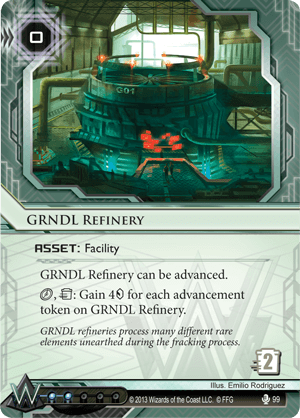
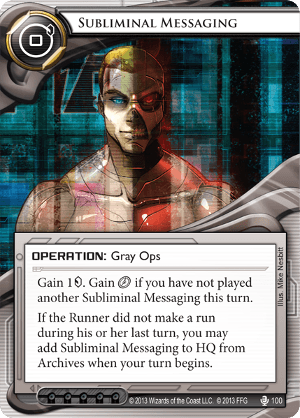
No comments:
Post a Comment